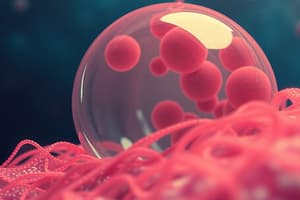Podcast
Questions and Answers
What is the primary function of the cell membrane?
What is the primary function of the cell membrane?
- To store genetic information
- To provide structural support to the cell
- To maintain the internal environment of the cell (correct)
- To facilitate the synthesis of proteins
What is the composition of the lipid bilayer in the cell membrane?
What is the composition of the lipid bilayer in the cell membrane?
- Primarily composed of nucleic acids and lipids
- Primarily composed of carbohydrates and proteins
- Primarily composed of amino acids and glycoproteins
- Primarily composed of phospholipids (correct)
What is the role of integral membrane proteins in cellular processes?
What is the role of integral membrane proteins in cellular processes?
- They are responsible for the replication of DNA
- They play a crucial role in various cellular processes (correct)
- They are involved in the breakdown of proteins
- They are involved in the synthesis of ATP
What is the characteristic of the hydrophilic head of phospholipids?
What is the characteristic of the hydrophilic head of phospholipids?
What type of membrane proteins interact with the lipid bilayer through non-covalent interactions?
What type of membrane proteins interact with the lipid bilayer through non-covalent interactions?
What is the function of the lipid bilayer in the cell membrane?
What is the function of the lipid bilayer in the cell membrane?
What is the primary function of proteins such as channels and pumps in the cell membrane?
What is the primary function of proteins such as channels and pumps in the cell membrane?
What is the term for the cell membrane's ability to respond to mechanical forces such as pressure and tension?
What is the term for the cell membrane's ability to respond to mechanical forces such as pressure and tension?
Which of the following factors influences the permeability of the cell membrane?
Which of the following factors influences the permeability of the cell membrane?
What is the process by which substances are moved across the cell membrane, requiring energy input?
What is the process by which substances are moved across the cell membrane, requiring energy input?
Which of the following is a consequence of low membrane fluidity?
Which of the following is a consequence of low membrane fluidity?
What is the term for the dynamic remodeling of the cell membrane in response to various cellular processes?
What is the term for the dynamic remodeling of the cell membrane in response to various cellular processes?
Flashcards are hidden until you start studying
Study Notes
Cell Membrane Physiology
Membrane Structure
The cell membrane, also known as the plasma membrane, is a semi-permeable structure that surrounds all living cells. It has a unique structure, consisting of a lipid bilayer with embedded proteins. The lipid bilayer is primarily composed of phospholipids, which have a hydrophilic (water-loving) head and a hydrophobic (water-hating) tail. The hydrophilic heads face outwards, interacting with water, while the hydrophobic tails face inwards, away from water. This arrangement allows the membrane to control the movement of molecules across it.
Membrane Proteins
Integral membrane proteins play crucial roles in various cellular processes. They are embedded in the lipid bilayer and can be categorized into three types: peripheral proteins, which interact with the lipid bilayer through hydrophilic interactions; integral proteins, which span the lipid bilayer and can be further divided into transmembrane proteins and lipid-anchored proteins; and membrane-associated proteins, which interact with the lipid bilayer through non-covalent interactions.
Membrane Function
The primary function of the cell membrane is to maintain the internal environment of the cell. It controls the movement of substances in and out of the cell, including nutrients, waste products, and signaling molecules. This selective permeability is achieved through the presence of proteins, such as channels and pumps, that facilitate the passage of specific molecules across the membrane.
Membrane Mechanosensitivity
Cell membranes are sensitive to mechanical forces, such as pressure and tension. This mechanosensitivity is crucial for various cellular functions, including cell locomotion, cell division, and tissue elasticity. Mechanosensitivity is mediated by several components, including the lipid matrix, cytoskeleton, and specific proteins, such as ion channels.
Membrane Permeability
The permeability of the cell membrane is a critical factor in cell physiology. It determines the ability of the cell to maintain its internal environment and respond to external stimuli. Membrane permeability is influenced by factors such as the lipid composition of the membrane, the presence of proteins, and the concentration gradient of molecules across the membrane.
Cell Membrane Dynamics
Cell membranes are dynamic structures that undergo constant remodeling in response to various cellular processes. This remodeling is driven by the activity of lipid-modifying enzymes, such as phospholipases and lipid kinases, which regulate the composition and organization of the membrane. Additionally, the cytoskeleton, a network of protein filaments within the cell, is involved in structural support and the movement of membrane components.
Membrane Transport
Membrane transport is the process by which substances are moved across the cell membrane. This can occur via passive diffusion, facilitated diffusion, or active transport, which requires energy input. Membrane transport plays a crucial role in maintaining the internal environment of the cell and in the uptake of nutrients and expulsion of waste products.
Membrane Fluidity
Membrane fluidity is a critical aspect of membrane physiology. It is influenced by factors such as the lipid composition of the membrane, temperature, and the presence of cholesterol. Membrane fluidity affects the function of proteins embedded in the membrane, as well as the organization of the membrane itself.
In conclusion, cell membrane physiology is a complex and multifaceted field that encompasses various aspects of cellular processes. Understanding the structure, function, and dynamics of cell membranes is essential for understanding the workings of living cells and the interactions between cells in multicellular organisms.
Studying That Suits You
Use AI to generate personalized quizzes and flashcards to suit your learning preferences.




